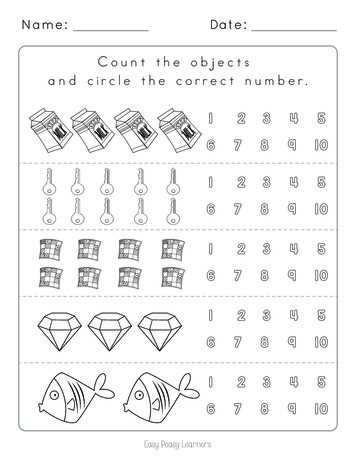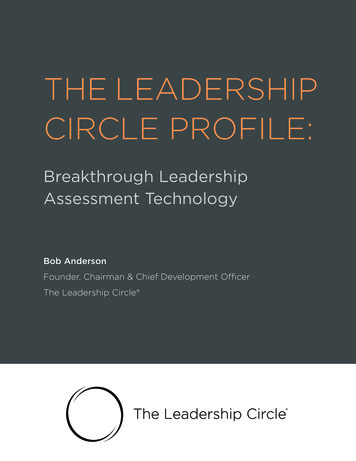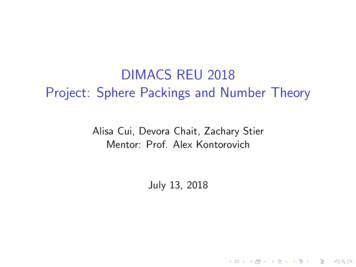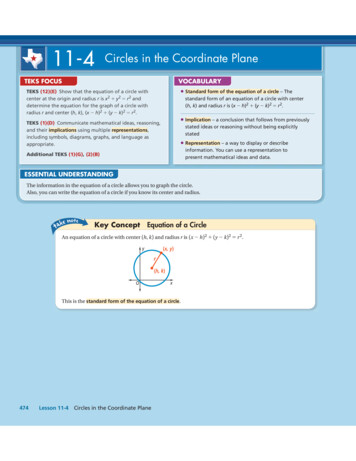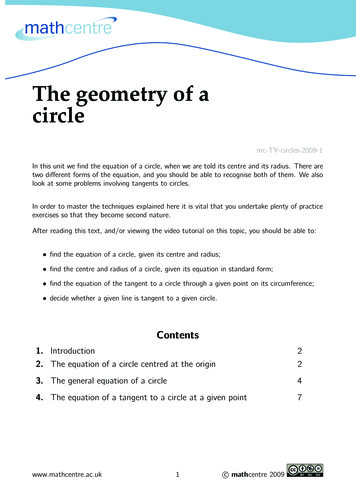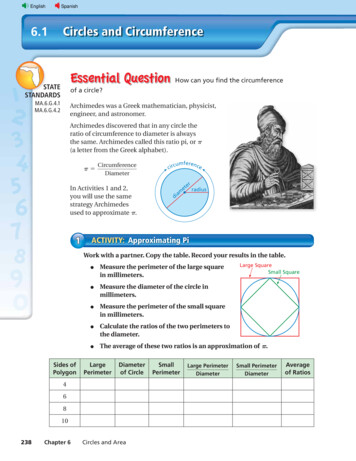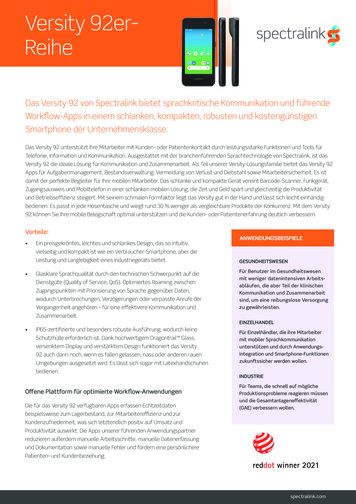
Transcription
AMIE(I)DATA STRUCTURESAALGORITHMSSTUDY CIRCLE(REGD.)FocusedApproach AlgorithmsINTRODUCTIONData structure is the structural representation of logical relationships between elements ofdata. In other words a data structure Is a way of organizing data Items by considering itsrelationship to each other.Data structure mainly specifies the structured organization of data, by providing accessingmethods with correct degree of association. Data structure affects the design of both thestructural and functional aspects of a program.Algorithm Data Structure ProgramALGORITHMAlgorithm is a step-by-step finite sequence of instruction, to solve a well-definedcomputational problem.That is, in practice to solve any complex real life problems; first we have to define theproblems. Second step is to design the algorithm to solve that problem.Writing and executing programs and then optimizing them may be effective for smallprograms. Optimization of a program is directly concerned with algorithm design. But for alarge program, each part of the program must be well organized before writing the program.There are few steps of refinement involved when a problem is converted to program; thismethod is called stepwise refinement method. There are two approaches for algorithm design;they are top-down and bottom-up algorithm design.TOP-DOWN ALGORITHM DESIGNThe principles of top-down design dictates that a program should be divided Into a mainmodule and Its related modules. Each module should also be divided Into sub modulesaccording to software engineering and programming style. The division of modules processesuntil the module consists only of elementary process that are Intrinsically understood andcannot be further subdivided.In C, the Idea of top-down design Is done using functions. A C program Is made of one ormore functions, one and only one of which must be named main. The execution of theprogram always starts and ends with main, but It can call other functions to do special tasks.BOTTOM-UP ALGORITHM DESIGNBottom-up algorithm design Is the opposite of top-down design. It refers to a style ofprogramming where an application Is constructed starting with existing primitives of theprogramming language, and constructing gradually more and more complicated features,until the all of the application has been written. That Is, starting the design with specificmodules and build them Into more complex structures, ending at the top.SECOND FLOOR, SULTAN TOWER, ROORKEE – 247667 UTTARAKHANDPH: (01332) 266328Web: www.amiestudycircle.com1/16
DATA STRUCTURESAMIE(I)STUDY CIRCLE(REGD.)A Focused Approach The bottom-up method Is widely used for testing, because each of the lowest-level functionsIs written and tested first. This testing Is done by special test functions that call the low-levelfunctions, providing them with different parameters and examining the results forcorrectness. Once lowest-level functions have been tested and verified to be correct, the nextlevel of functions may be tested. Since the lowest-level functions already have been tested,any detected errors are probably due to the higher-level functions. This process continues,moving up the levels, until finally the main function Is tested.ALGORITHMSANALYSIS OF ALGORITHMAfter designing an algorithm, it has to be checked and its correctness needs to be predicted;this is done by analyzing the algorithm. The algorithm can be analyzed by tracing all step-bystep instructions, reading the algorithm for logical correctness, and testing it on some datausing mathematical techniques to prove it correct. Another type of analysis is to analyze thesimplicity of the algorithm. That is, design the algorithm in a simple way so that it becomeseasier to be implemented. However, the simplest and most straightforward way of solving aproblem may not be sometimes the best one. Moreover there may be more than one algorithmto solve a problem. The choice of a particular algorithm depends on following performanceanalysis and measurements : Space complexity Time complexitySPACE COMPLEXITYAnalysis of space complexity of an algorithm or program is the amount of memory it needs torun to completion.Some of the reasons for studying space complexity are: If the program is to run on multi user system, it may be required to specify the amountof memory to be allocated to the program. We may be interested to know in advance that whether sufficient memory is availableto run the program. There may be several possible solutions with different space requirements. Can be used to estimate the size of the largest problem that a program can solve.The space needed by a program consists of following components. Instruction space : Space needed to store the executable version of the program and itis fixed. Data space : Space needed to store all constants, variable values and has further twocomponents :o Space needed by constants and simple variables. This space is fixed.o Space needed by fixed sized structural variables, such as arrays and structures.SECOND FLOOR, SULTAN TOWER, ROORKEE – 247667 UTTARAKHANDPH: (01332) 266328Web: www.amiestudycircle.com2/16
DATA STRUCTURESAMIE(I)A FocusedDynamically allocated space. This space usually varies.ALGORITHMS STUDY CIRCLE(REGD.)Approach Environment stack space: This space is needed to store the information to resume thesuspended (partially completed) functions. Each time a function is invoked thefollowing data is saved on the environment stack :o Return address : i.e., from where it has to resume after completion of thecalled function.o Values of all lead variables and the values of formal parameters in the functionbeing invoked .The amount of space needed by recursive function is called the recursion stack space. Foreach recursive function, this space depends on the space needed by the local variables and theformal parameter. In addition, this space depends on the maximum depth of the recursion i.e.,maximum number of nested recursive calls.TIME COMPLEXITYThe time complexity of an algorithm or a program is the amount of time it needs to run tocompletion. The exact time will depend on the implementation of the algorithm,programming language, optimizing the capabilities of the compiler used, the CPU speed,other hardware characteristics/specifications and so on. To measure the time complexityaccurately, we have to count all sorts of operations performed in an algorithm. If we know thetime for each one of the primitive operations performed in a given computer, we can easilycompute the time taken by an algorithm to complete its execution. This time will vary frommachine to machine. By analyzing an algorithm, it is hard to come out with an exact timerequired. To find out exact time complexity, we need to know the exact instructions executedby the hardware and the time required for the instruction. The time complexity also dependson the amount of data inputted to an algorithm. But we can calculate the order of magnitudefor the time required.That is, our intention is to estimate the execution time of an algorithm irrespective of thecomputer machine on which it will be used. Here, the more sophisticated method is toidentify the key operations and count such operations performed till the program completesits execution. A key operation in our algorithm is an operation that takes maximum timeamong all possible operations in the algorithm. Such an abstract, theoretical approach is notonly useful for discussing and comparing algorithms, but also it is useful to improve solutionsto practical problems. The time complexity can now be expressed as function of number ofkey operations performed. Before we go ahead with our discussions, it is important tounderstand the rate growth analysis of an algorithm, as shown in following figure.SECOND FLOOR, SULTAN TOWER, ROORKEE – 247667 UTTARAKHANDPH: (01332) 266328Web: www.amiestudycircle.com3/16
DATA STRUCTURESALGORITHMSAMIE(I)ASTUDY CIRCLE(REGD.)FocusedApproach The function that involves ‘n’ as an exponent, i.e., 2n, nn, n! are called exponential functions,which is too slow except for small size input function where growth is less than or equal tonc,(where ‘c’ is a constant) i.e.; n3, n2, n log2n, n, log2n are said to be polynomial.Algorithms with polynomial time can solve reasonable sized problems if the constant in theexponent is small.When we analyze an algorithm it depends on the input data, there are three cases : Best case Average case Worst caseIn the best case, the amount of time a program might be expected to take on best possibleinput data.In the average case, the amount of time a program might be expected to take on typical (oraverage) input data.In the worst case, the amount of time a program would take on the worst possible inputconfiguration.Time Complexity of Bubble SortIn the first pass of bubble sort, in worst case it must make N - l comparisons. In the next passit must make N - 2 comparisons and so on. The algorithm terminates after maximum N- 1SECOND FLOOR, SULTAN TOWER, ROORKEE – 247667 UTTARAKHANDPH: (01332) 266328Web: www.amiestudycircle.com4/16
AMIE(I)DATA STRUCTURESSTUDY CIRCLE(REGD.)A Focused Approach pass (or earlier if there are no exchanges in a pass). Thus the total number of comparisonswill beALGORITHMS( N 1) ( N 2) ( N 3) .3 2 1 N ( N 1) N 2 N O( N 2 )222TIME-SPACE TRADE OFFThere may be more than one approach (or algorithm) to solve a problem. The best algorithm(or program) to solve a given problem is one that requires less space in memory and takesless time to complete its execution. But in practice, it is not always possible to achieve bothof these objectives. One algorithm may require more space but less time to complete itsexecution while the other algorithm requires less time space but takes more time to completeits execution. Thus, we may have to sacrifice one at the cost of the other. If the space is ourconstraint, then we have to choose a program that requires less space at the cost of moreexecution time. On the other hand, if time is our constraint such as in real time system, wehave to choose a program that takes less time to complete its execution at the cost of morespace.ASYMPTOTIC NOTATIONAsymptotic notation is the most simple and easiest way of describing the running time of analgorithm. It represents the efficiency and performance of an algorithm in a systematic andmeaningful manner. Asymptotic notations describe time complexity in terms of threecommon measures, best case (or 'fastest possible'), worst case (or 'slowest possible'), andaverage case (or 'average time'). The three most important asymptotic notations are: Big-Oh notation Omega notation Theta notationBig “O” NotationBig O is a characteristic scheme that measures properties of algorithm complexityperformance and/or memory requirements. The algorithm complexity can be determined byeliminating constant factors in the analysis of the algorithm. Clearly, the complexity functionf(n) of an algorithm increases as ‘n’ increases.Let us find out the algorithm complexity by analyzing the sequential searching algorithm. Inthe sequential search algorithm we simply try to match the target value against each value inthe memory. This process will continue until we find a match or finish scanning the wholeelements in the array. If the array contains ‘n’ elements, the maximum possible number ofcomparisons with the target value will be ‘n’ i.e., the worst case. That is the target value willbe found at the nth position of the array.f(n) nSECOND FLOOR, SULTAN TOWER, ROORKEE – 247667 UTTARAKHANDPH: (01332) 266328Web: www.amiestudycircle.com5/16
DATA STRUCTURESAMIE(I)STUDY CIRCLE(REGD.)A Focused Approach i.e., the worst case is when an algorithm requires a maximum number of iterations or steps tosearch and find out the target value in the array.ALGORITHMSThe best case is when the number of steps is less as possible. If the target value is found in asequential search array of the first position (i.e., we need to compare the target value withonly one element from the array) - we have found the element by executing only one iteration(or by least possible statements)f(n) 1Average case falls between these two extremes (i.e., best and worst). If the target value isfound at the n/2nd position, on an average we need to compare the target value with only halfof the elements in the array, sof(n) n/2The complexity function f(n) of an algorithm increases as ‘n’ increases. The function f(n) O(n) can be read as “f of n is big O of n” or as “f(n) is of the order of n”. The total runningtime (or time complexity) includes the initializations and several other iterative statementsthrough the loop.Then,f (n) O(nk)Based on the time complexity representation of the big Oh notation, the algorithm can becategorized as :1. Constant time O(1)2. Logarithmic time Olog(n)3. Linear time O(n)4. Polynomial time O(nc), if c 15. Exponential time O(cn), if c 1Limitation Of Big “O” NotationBig O Notation has following two basic limitations : It contains no effort to improve the programming methodology. Big O Notation doesnot discuss the way and means to improve the efficiency of the program, but it helpsto analyze and calculate the efficiency (by finding time complexity) of the program. It does not exhibit the potential of the constants. For example, one algorithm is taking1000n2 time to execute and the other n3 time. The first algorithm is O(n2), whichimplies that it will take less time than the other algorithm which is O(n3). However inactual execution the second algorithm will be faster for n 1000.We will analyze and design the problems in data structure. As we have discussed to develop aprogram of an algorithm, we should select an appropriate data structure for that algorithm.SECOND FLOOR, SULTAN TOWER, ROORKEE – 247667 UTTARAKHANDPH: (01332) 266328Web: www.amiestudycircle.com6/16
AMIE(I)DATA STRUCTURESAALGORITHMSSTUDY CIRCLE(REGD.)FocusedApproach Little O NotationThe little O is denoted as o. It is defined as : Let, f(n) and g(n) be the non negative functionsthenlim n f ( n) 0g ( n)such that f(n) o(g(n))Theta notationf (n) ( g (n))read as f of n equal lo theta of g(n) if and only if, there exists positive constants Q.C1 and C2such that for all n n0C1 g (n) f (n) C2 g (n) If f(n) (g(n)) and g(n) both an upper and lower bound on f(n). i.e. worst and best casesrequire the same amount of time to within constant factor.ExampleShow that n log(n) (log(n !))Solution notation is used for tight boundWe known! nni.e.log(n !) log(n n ) n log nlog(n!) log(1) log (2) . log(n – 1) log(n)We can get upper bound bylog(1) log (2) . log(n) log(n) log(n) . log(n) nlog(n)We can get lower bound by throwing away first half of the sumlog(1) log(2) . log(n/2) .log(n) log(n/2) .log(n) log(n/2) . log(n/2) (n/2)*log(n/2)For the same values of n there is a tight lower bound and also for same values of n there istight upper bound. hence n log n (log(n !))EFFICIENCY OF ALGORITHMIf we have two algorithms that perform same task, and the first one has a computing time ofO(n) and the second of O(n2), then we will usually prefer the first one.The reason for this is that as n increases the time required for the execution of secondalgorithm will get far more than the time required for the execution of first.SECOND FLOOR, SULTAN TOWER, ROORKEE – 247667 UTTARAKHANDPH: (01332) 266328Web: www.amiestudycircle.com7/16
DATA STRUCTURESAMIE(I)STUDY CIRCLE(REGD.)A Focused Approach We will study various values for computing function for the constant values. The graph givenbelow will indicate the rate of growth of common computing time functions.ALGORITHMSNotice how the times O(n) and O(n log2n) grow much more slowly than the others. For largedata sets algorithms with a complexity greater than O(n log2n) are often impractical. The veryslow algorithm will be the one having time complexity 2n.Examplef(n) 3n3 2n2 4n 3 3n3 2n2 O(n), as 4n 3 is of O(n) 3n3 O(n2), as 2n2 O(n) is O (n2) O (n3)ExampleWhich time complexity shows poor performance? Why?SECOND FLOOR, SULTAN TOWER, ROORKEE – 247667 UTTARAKHANDPH: (01332) 266328Web: www.amiestudycircle.com8/16
DATA STRUCTURESALGORITHMSAMIE(I)ASTUDY CIRCLE(REGD.)FocusedApproach SolutionSee table.Thus as the value of n increases the value of 2n becomes the largest among all the timecomplexity values. The program, which gives the time complexity value large, is supposed tobe the slow one that is why it is said that the program having the time complexity 2n is poorin performance.ExampleFind the frequency count for the following piece of code.sum 0;for (i 1; i n; i )sum sum a[i]SolutionLet us write stepwiseStep1: sum 0;Step 2: for (i 1; i n; i )Step 3: sum sum a[i]Total frequency count l l (n l) n n 3n 3. The time complexity will be O(n).SECOND FLOOR, SULTAN TOWER, ROORKEE – 247667 UTTARAKHANDPH: (01332) 266328Web: www.amiestudycircle.com9/16
AMIE(I)DATA STRUCTURESAALGORITHMSSTUDY CIRCLE(REGD.)FocusedApproach Example (AMIE S11, 4 marks)Suppose T1(n) and T2 (n) are the time complexities of two program fragments P1 and P2,where T1(n) O(f(n)) and T2 O(g(n)). What is the time complexity of program fragment P1followed by P2?SolutionThe time complexity of the program fragment P1 followed by P2 is given by T1(n) T2(n).T1(n) C.f(n) for some positive integer C and positive and positive integer n1, such that n n1.T2(n) D.g(n) for some positive integer d and positive and positive integer n2, such that n n2.Let n0 max (n1, n2). Then T1(n) T2(n) C.f(n) D.g(n) for n n0 i.e. T1(n) T2(n) (C D) max(f(n), g(n)) for n n0.Hence T1(n) T2(n) 0 (max(f(n), g(n))Example (AMIE W10 6 marks)Suppose f1 (n) O(t (n)) and f 2 (n) O(t (n)) . Which one of the following is true? In case anoption is false, give reasons that why is it false.(i) f1 (n) f 2 (n) O(t (n))(ii) f1 (n) f 2 (n) O(t (n))(iii) f1 (n) / f 2 (n) O (1)(iv) f1 (n) O( f 2 (n))Solution(i)If f1(n) Og1(n) and f2(n) Og2(n) then f1(n) f2(n) O(max (g1(n), g2(n)). here sinceboth f1and f2 are O (t(n)), max (t(n), t(n)) t(n). Thusf1 (n) f 2 (n) O(t (n)) True(ii)Similarlyf1 (n) f 2 (n) Ot (n) True(iii)Heref1 (n) / f 2 (n) const. since both are O(t(n))Hence f1 (n) / f 2 (n) O(1)(iv)TrueSince f1 (n) O(t (n)) and f 2 (n) O(t (n))f n (n) O(cf 2 (n)) where c is a constant.SECOND FLOOR, SULTAN TOWER, ROORKEE – 247667 UTTARAKHANDTruePH: (01332) 266328Web: www.amiestudycircle.com10/16
AMIE(I)DATA STRUCTURESAALGORITHMSSTUDY CIRCLE(REGD.)FocusedApproach Example (AMIE W10, S11, 4 marks)Suppose P(n) a0 a1n a2nm, that is, suppose degree P(n) m. Prove that P(n) O(nm).Solutionb0 a0 b1 a1 .bm am LetThen for n 1P(n) b0 b1n b2 n 2 .bm n mb b 0m m1 1 .bm n m (b0 b1 .bm )n m Mn mnn whereM a0 a1 a2 . am HenceP ( n) O ( n m )SPACE COMPLEXITYAnother useful measure of an algorithm is the amount of storage space it needs. The spacecomplexity of an algorithm can be computed by considering the data and their sizes. Againwe are concerned with those data items which demand for maximum storage space. A similarnotation 'O' is used to denote the space complexity of an algorithm. When computing forstorage requirement we assume each data element needs one unit of storage space. While asthe aggregate data items such as arrays will need n units of storage space n is the number ofelements in an array. This assumption again is independent of the machines on which thealgorithms are to be executed.The space complexity of a computer program is the amount of memory required for its properexecution. The important concept behind space required is that unlike time, space can bereused during the execution of the program. As discussed, there is often a trade-off betweenthe time and space required to run a program.In formal definition, the space complexity is defined as follows:Space complexity of a Turing Machine: The (worst case) maximum length of the taperequired to process an input string of length n.ExampleConsider the following example: Binary Recursion (A binary-recursive routine (potentially)calls itself twice).1. If n equals 0 or 1, then return 12. Recursively calculate f (n 1)3. Recursively calculate f (n 2)4. Return the sum of the results from steps 2 and 3.SECOND FLOOR, SULTAN TOWER, ROORKEE – 247667 UTTARAKHANDPH: (01332) 266328Web: www.amiestudycircle.com11/16
AMIE(I)DATA STRUCTURESAALGORITHMSSTUDY CIRCLE(REGD.)FocusedApproach Time Complexity: O(exp n)Space Complexity: O(exp n)SPARSE ARRAYIf we are reading or writing two-dimensional array, two loops are required. Similarly thearray of ‘n’ dimensions would require ‘n’ loops. The structure of the two dimensional array isillustrated in the following figure :int A[10][10];Two Dimensional ArraySparse array is an important application of arrays. A sparse array is an array where nearly allof the elements have the same value (usually zero) and this value is a constant. Onedimensional sparse array is called sparse vectors and two-dimensional sparse arrays are calledsparse matrix.The main objective of using arrays is to minimize the memory space requirement and toimprove the execution speed of a program. This can be achieved by allocating memory spacefor only non-zero elements.For example a sparse array can be viewed asWe will store only non-zero elements in the above sparse matrix because storing all theelements of the sparse array will be consisting of memory sparse. The non-zero elements arestored in an array of the form.SECOND FLOOR, SULTAN TOWER, ROORKEE – 247667 UTTARAKHANDPH: (01332) 266328Web: www.amiestudycircle.com12/16
DATA STRUCTURESALGORITHMSAMIE(I)ASTUDY CIRCLE(REGD.)FocusedApproach A[0.n][1.3]Where ‘n’ is the number of non-zero elements in the array. In the above Fig. of twodimensional array ‘n 7’.The space array given in two dimensional array above may be represented in the arrayA[0.7][1.3].The element A[0][1] and A[0][2] contain the number of rows and columns of the sparsearray. A[0][3] contains the total number of nonzero elements in the sparse array.A[1][1] contains the number of the row where the first nonzero element is present in thesparse array. A[1][2] contains the number of the column of the corresponding nonzeroelement. A[1][3] contains the value of the nonzero element. In the Fig. of two dimensionalarray, the first nonzero element can be found at 1st row in 3rd column.FILES AND RECORDSA file is typically a large list that is stored in the external memory (e.g. a magnetic disk) of acomputer.A record is a collection of information (or data items) about a particular entity. Morespecifically, a record is a collection of related data items, each of which is called a filed orattribute and a file is a collection of similar records.Although a record is a collection of data items, it differs from a linear array in the followingways: A record may be a collection of non-homogeneous data: i.e. the data items in a recordmay have different data types. The data items in a record are indexed by attribute names, so there may not be anatural ordering of its elements.SECOND FLOOR, SULTAN TOWER, ROORKEE – 247667 UTTARAKHANDPH: (01332) 266328Web: www.amiestudycircle.com13/16
AMIE(I)DATA STRUCTURESAALGORITHMSSTUDY CIRCLE(REGD.)FocusedApproach STRINGSIn computer terminology the term ‘string’ refers to a sequence of characters. A finite set ofsequence (alphabets, digits or special characters) of zero or more characters is called a string.The number of characters in a string is called the length of the string. If the length of thestring is zero then it is called the empty string or null string.Strings are stored or represented in memory by using following three types of structures: Fixed length structures Variable length structures with fixed maximum Linear structuresFixed Length RepresentationIn fixed length storage each line is viewed as a record, where all records have the samelength. That is each record accommodates maximum of same number of characters.The main advantage of representing the string in the above way is : To access data from any given record easily. It is easy to update the data in any given record.The main disadvantages are : Entire record will be read even if most of the storage consists of inessential blankspace. Time is wasted in reading these blank spaces. The length of certain records will be more than the fixed length. That is certainrecords may require more memory space than available.Fig. (b) is a representation of input data which is in Fig. (a) in a fixed length (records) storagemedia in a computer.(a) Input Data(b) Fixed Length RepresentationVariable Length RepresentationIn variable length representation, strings are stored in a fixed length storage medium. This isdone in two ways.SECOND FLOOR, SULTAN TOWER, ROORKEE – 247667 UTTARAKHANDPH: (01332) 266328Web: www.amiestudycircle.com14/16
DATA STRUCTURESAMIE(I)STUDY CIRCLE(REGD.)A Focused Approach 1. One can use a marker, (any special characters) such as two-dollar sign ( ), to signalthe end of the string.ALGORITHMS2. Listing the length of the string at the first place is another way of representing stringsin this method.Linked List RepresentationsIn linked list representations each characters in a string are sequentially arranged in memorycells, called nodes, where each node contain an item and link, which points to the next nodein the list (i.e., link contain the address of the next node).SECOND FLOOR, SULTAN TOWER, ROORKEE – 247667 UTTARAKHANDPH: (01332) 266328Web: www.amiestudycircle.com15/16
DATA STRUCTURESALGORITHMSAMIE(I)ASTUDY CIRCLE(REGD.)FocusedApproach ASSIGNMENTQ.1. (AMIE S12, 5 marks): Define Big O notation and what is its utility in analysis of algorithms?Q.2. (AMIE S13, 4 marks): What is asymptotic little O notation (o)? What is big O notation?Q.3. (AMIE S07, 12 marks): What do you mean by efficiency of an algorithm? How can you compare theefficiency of two algorithms? Explain the concept of best case, average case and worst case time complexity.Q.4. (AMIE S12, 6 marks): What is worst case and average case analysis?Q.5. (AMIE W07, 10 marks): Define (i) Time complexity (ii) space complexity (iii) array representation ofstrings (iv) record (v) abstract data typeQ.6. (AMIE S12, 5 marks): Describe briefly three types of structures used for storing strings.Q.7. (AMIE S13, 6 marks): What is time complexity of an algorithm? Calculate run time complexity of bubblesort.Q.8. (AMIE S11, 5 marks): Order the following function by growth rate: N, N, N1.5, N2, NlogN, NloglogN,Nlog(N2), 2/N, 2N, 37(For online support such as eBooks, video lectures, audio lectures, unsolved papers, quiz, test series and course updates,visit www.amiestudycircle.com)SECOND FLOOR, SULTAN TOWER, ROORKEE – 247667 UTTARAKHANDPH: (01332) 266328Web: www.amiestudycircle.com16/16
DATA STRUCTURES ALGORITHMS SECOND FLOOR, SULTAN TOWER, ROORKEE - 247667 UTTARAKHAND PH: (01332) 266328 Web: www.amiestudycircle.com 4/16 AMIE(I) STUDY CIRCLE(REGD.) A Focused Approach The function that involves 'n' as an exponent, i.e., 2n, nn, n! are called exponential functions, which is too slow except for small size input function where growth is less than or equal to
